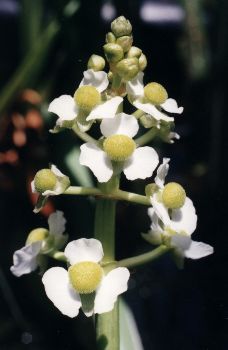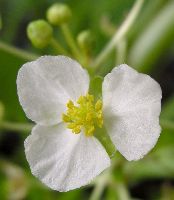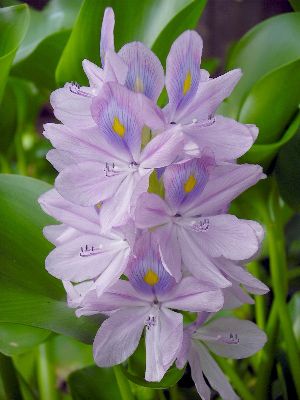Pond Plant Pair
by Valerie (May 15, 2000)
revised August 12, 2003
 We have several types of plants in our ponds, but two are very large and showy. The first of these is the delta arrowhead (Sagittaria platyphylla), a member of the water-plantain family (Alismataceae). The plant grows wild in spring fed rivers which don't dry up every summer. We have a potted plant that is at least eight years old; having definitely outgrown the pot, it now encompasses it with its roots and sends out runners producing new plants from spring through autumn. During the winter, the part above the water freezes back, but the lower part remains safe. We have several types of plants in our ponds, but two are very large and showy. The first of these is the delta arrowhead (Sagittaria platyphylla), a member of the water-plantain family (Alismataceae). The plant grows wild in spring fed rivers which don't dry up every summer. We have a potted plant that is at least eight years old; having definitely outgrown the pot, it now encompasses it with its roots and sends out runners producing new plants from spring through autumn. During the winter, the part above the water freezes back, but the lower part remains safe.
Arrowhead has edible roots and is known by a variety of names: duck potato, arrowleaf, swan potato, wapatoo, katniss, swamp potato and tule potato.
The water hyacinth is a member of the pickerelweed family (Pontederiaceae), and indeed the blossoms look just like giant versions of those of the pickerelweed. It blooms constantly through the warm months, producing lovely clusters of purple flowers that all open at once, hence the resemblance to the hyacinth. Sometimes, only some of the flowers on a stem open the first day. The second day, the rest open, but the stem is already beginning its post-blossoming position: curving downwards into the water. Our flowers have never produced any seeds and the spent flowers just end up in the water and rot away. The water hyacinths are not handicapped by such a minor concern as lack of pollination, however, and they reproduce at a remarkable rate all summer long through the production of runners and new plants. The plants need to be thinned out periodically or they would cover the whole pond in no time. Unfortunately, due to space constraints and the endangered species act, we don't have in our ponds the one creature that seems to eat water hyacinths with relish: the manatee. |
 There are two kinds of leaves on the arrowhead: one is a flat, underwater type that doesn't widen at any point, which looks like very thick grass, and the other is the tall, upright kind with a spoon-shaped blade, which grows above the surface of the water. Just as the leaves come in two types, so do the flowers. Both male and female flowers are small and white, but the female blooms (photo at left) open first, at the bottom of the flower clusters and produce green clusters of seeds almost immediately after pollination. When these are ripe, they burst apart into hundreds of tiny oily seeds floating on the surface of the water. The male flowers (photo at right) open after the lower flowers and are filled with pollen-laden stamens which attract mostly tiny wasps. I suspect the reason for the flowers opening at different times is to prevent self fertilization.
There are two kinds of leaves on the arrowhead: one is a flat, underwater type that doesn't widen at any point, which looks like very thick grass, and the other is the tall, upright kind with a spoon-shaped blade, which grows above the surface of the water. Just as the leaves come in two types, so do the flowers. Both male and female flowers are small and white, but the female blooms (photo at left) open first, at the bottom of the flower clusters and produce green clusters of seeds almost immediately after pollination. When these are ripe, they burst apart into hundreds of tiny oily seeds floating on the surface of the water. The male flowers (photo at right) open after the lower flowers and are filled with pollen-laden stamens which attract mostly tiny wasps. I suspect the reason for the flowers opening at different times is to prevent self fertilization.
 The second plant presented here is the water hyacinth (Eichhornia crassipes), notorious for completely blocking canals and rivers in the Florida and along the Gulf coast. In our area of Texas, they are not a problem since they easily freeze during the winter and, having no deep roots (they just float, by means of an enlarged bulb filled with air pockets at the base of each leaf stem), they don't survive. They do manage to live near springs, where the water temperature stays warm enough that they don't freeze completely, but in our ponds, they must be brought in during low temperatures.
The second plant presented here is the water hyacinth (Eichhornia crassipes), notorious for completely blocking canals and rivers in the Florida and along the Gulf coast. In our area of Texas, they are not a problem since they easily freeze during the winter and, having no deep roots (they just float, by means of an enlarged bulb filled with air pockets at the base of each leaf stem), they don't survive. They do manage to live near springs, where the water temperature stays warm enough that they don't freeze completely, but in our ponds, they must be brought in during low temperatures.